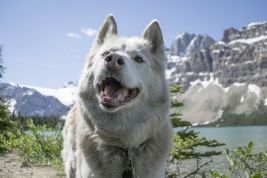 We are blessed to live in a country where nature is so abundant. Spending time outdoors,
whether it's going for a hike or just relaxing, is one of the joys of spending time with
our four-legged pals. With nature comes wildlife. Luckily, wild animals are generally
happy to stay peacefully away from both humans and dogs. Even so, interactions between
wild animals and pets do occasionally happen. Here are some tips on
keeping your pets safe around wildlife.
We are blessed to live in a country where nature is so abundant. Spending time outdoors,
whether it's going for a hike or just relaxing, is one of the joys of spending time with
our four-legged pals. With nature comes wildlife. Luckily, wild animals are generally
happy to stay peacefully away from both humans and dogs. Even so, interactions between
wild animals and pets do occasionally happen. Here are some tips on
keeping your pets safe around wildlife.
Raccoon can be utterly adorable. They can also carry rabies as well as parasites which can spread to your dog. Raccoon feces are a common way to spread parasites and many dogs find them irresistible. Raccoons are likely to run away from a dog but they can fight ferociously, if need be.
Anyone who has ever had the misfortune of having their dog "skunked" will tell you just how awful it is! The oily, stinky mess is hard to get out of the pet's fur, not to mention very unpleasant. And what's worse, the endless baths, though helpful in reducing the stench, never seem to make it go away for good - the dog gets wet in the rain, for example, and that terrible smell returns, sometimes for months on end. Skunks can also carry rabies.
Deer have a reputation for being lovely, gentle creatures. In the right situation, though, they can be fierce, a scary situation when confronted with an animal so large! If threatened, deer may resort to stomping dogs with their powerful hooves.
Hawk, eagle, and owl are common sights. They're fast and often silent. They can easily swoop down and grab a small dog or a cat before the owner even realizes what's happening.
Bear tend to be peace-loving animals who prefer to stay away from people and dogs, if given the chance. Stay alert and carry bear spray if you're hiking in bear country. Don't allow your dog to chase or harass them. A mother bear with cubs may feel the need to defend them, but any situation with any bear could turn dangerous if they feel threatened.
These lumbering creatures have a built-in defense system: any dog who dares to get too close, let alone tries to take a bite, is going to sorely regret it. The barbed quills embed themselves in the face, paws, and body of the unlucky pet who chooses to engage with a porcupine. It's extremely painful and removing the quills requires a vet visit where pets need to be put under sedation or anesthesia in order to remove the quills. Quills can sometimes be embedded deeper in the body and can even migrate to other parts of the body. Pets who have been quilled need to be monitored for any ongoing health concerns.
Most wild cats are happy to keep to themselves. Infrequently, a hungry cat may come into human-occupied spaces and carry off a pet.
Coyote can be found in many urban areas. These beautiful creatures are smart and adaptable, happy to eat whatever's on offer - including dogs and cats. People have encountered extremely bold coyote who appear unafraid of humans or their dogs. There have been many reports of coyotes snatching pets right off the ends of their leashes! Be watchful and cautious in coyote territory. Don't allow dogs to chase them; it's dangerous for both the dog and for the coyote.